Why ProFlow Injector Service is a MUST!
- Injectors are now fitted as standard on all vehicles produced and sold in the United States.
- It is impossible for the technician, to correctly and accurately diagnose faults on a fuel injection systems, without considering the injectors condition and performance.
- It is impossible for the technician to adjust the engine correctly, if it has poor injector performance.
- Lacquering of inlet valves, excessive bore wear, carbon deposits on sensors, clogging of Catalytic Converters, could all be a result of poor injector performance.
- The injector valves are now one of the major components in the controlling and reduction of exhaust emissions.
- A reduction in the Fuel Droplet size will increase performance, improve fuel economy, and reduce exhaust pollution.
Most Importantly, there is no equipment currently available that will enable the technician to accurately analyze the condition of the injectors while they are on the car.
Keep your engine running smoothly
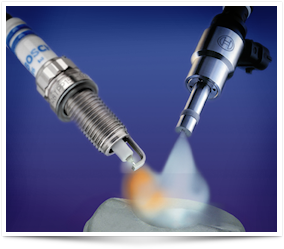 The Internal Combustion Engine requires three elements to function correctly:
The Internal Combustion Engine requires three elements to function correctly:
AIR – IGNITION – FUEL
The correct supply of all three are important, but only one is the pollutant… The Fuel. Correct delivery, correct distribution & correct atomization is not an option.
On the whole of Fuel Injection System, there is only one component that actually does the fuel injecting… THE FUEL INJECTOR VALVES
The Bosch solenoid Multi-Point injector, is designed to operate with a minimum life of 1 Billion pulses. In 1990, Robert Bosch produced more than 100,000 solenoid injectors per day. Since 1990, the injected vehicle market has quadrupled. The highest demands are made upon the injector during manufacturing. In the manufacture of the valve needle and assembly of the injector, tolerances of 1 micron apply. When the solenoid windings are energized, the valve needle lifts by about 0.06mm (according to the valve design) and the fuel is then injected through a calibrated metering gap.
Very high demands are placed on EFI equipped engines with regards to starting, performance, drive-ability, fuel consumption and exhaust gas values. Fuel injectors have a decisive influence upon all of these characteristics, and must therefore comply with stringent quality standards.
- A poor spray pattern will cause variances in air flow ratios
- Poor spray patterns can wash down manifold walls, reduce bore life and gum valves
- Clogged injectors will have poor atomization of fuel reducing performance and economy
- Clogged injectors can drip fuel into cylinders contaminating crankcase oil reducing engine life
- Badly leaking injectors could hydro lock the motor worst case -injectors must flow at rates within allowable tolerance, typically 3-5% of each other for
- If cleaning does not cure and match the set the unacceptable injector will need replaced
- For performance engines, the injectors should be within at least 2-3% of each other
- Off-the-vehicle servicing and testing is the only way to verify that each injector is doing its job and allowing each cylinder to operate evenly for peak performance and also can improve fuel economy
GIVE US A CALL AT 727-992-0435
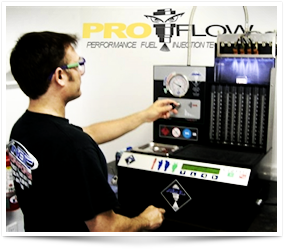
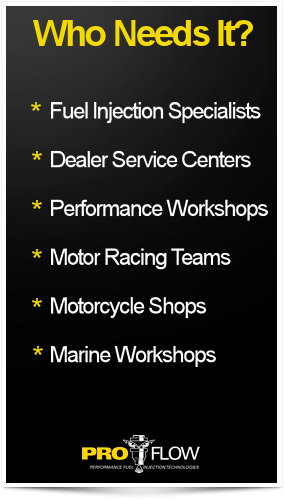
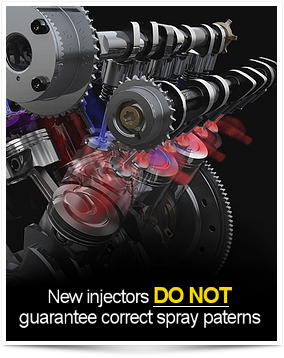
How exactly does a fuel injector work?
 The injector is located in the inlet manifold of the engine and sealed in between the manifold and fuel supply rail by rubber seals. A fuel pump pressurizes the system to normally about 2.5 bar.
The injector is located in the inlet manifold of the engine and sealed in between the manifold and fuel supply rail by rubber seals. A fuel pump pressurizes the system to normally about 2.5 bar.
The Engine Control Unit (ECU) gathers information from the various sensors located around the engine and using this information, the ECU determines the opening duration required for that combustion stroke. To do this, the ECU generates a current and transmits it to the solenoid of the injector.
The solenoid will magnetically lift the pintle valve needle from the seat of the injector, varying between 60 -100 microns. While the valve is raised, the pressurized fuel is forced through the orifice gap in the bottom of the injector, on to the pintle head or orifice plate and form a spray pattern shape as nominated by the head or plate design.
The injector will remain open for anywhere between 1 – 20 milliseconds, at a frequency of 3 – 125 Hz, depending on the engines requirements. When the current is stops, a small coil spring pushes the valve needle to the pintle seat and stops any further fuel from passing through. This process is repeated many time a second.
The Injector Valve has the finest tolerances of any mechanical component on the engine. We are constantly checking Milliseconds, Millivolts, Milliamps. When do we check Milliliters?
Unburnt fuel is the biggest issue on the petrol combustion engine today, how often do we check the Milliliters of Fuel delivered. We change Air Filters, Oil Filters, Fuel Filters, how often do we change Injector Filters?
The Electronic Injector is a sealed unit and cannot be dismantled or have any of its internal components replaced. Only the external components and internal filter can be replaced. All rubber Fuel & Air seals should be replaced if injector are removed from engine.
The fuel injectors impact on a vehicles performance
Correct spray patterns are critical to good performance, fuel economy, drive-ability and exhaust emissions. New injectors do not guarantee correct spray patterns, as this photo shows. The Spray Pattern has two major functions;
To distribute the fuel evenly & atomize the fuel evenly
In the event that the distribution or atomization should change, the mixture in the combustion chamber will also change, resulting in idling, performance, economy and emission problems. On simultaneous injection systems, the spray was regarded as important, on sequential injection systems, the spray pattern performance is critical to the correct running of the engine and the function of the emission control components.

Flow Testing with the Pro Flow Technologies Patented ASNU Machine
- Injectors are externally cleaned, visual inspected, and numbered.
- Test injectors for resistance, shorts, and current draw.
- Perform leak test, spray pattern, and flow rate testing on our state-of-the-art ASNU Machine. We then record the results.
- Remove filter baskets, o-rings, and pintle caps (if needed). Bead-blast any loose paint and rust from the metal injector body (if needed).
- The injectors are cycled through the ASNU ultrasonic cleaning tank to remove any particles and dirt for 45 minutes.
- A high pressure back-flush is done to remove any particles inside.
- Back to the flow bench for retesting of spray pattern, flow rate, and leak checking. This test data is also recorded
- Install new filter baskets, o-rings, and pintle caps. (as required, additional cost will apply)
- Prepare a comprehensive test report with before and after test data. The injectors are then packed along with the old parts for return.
Pro Flow Technologies Patented ASNU Ultrasonic Cleaning Process
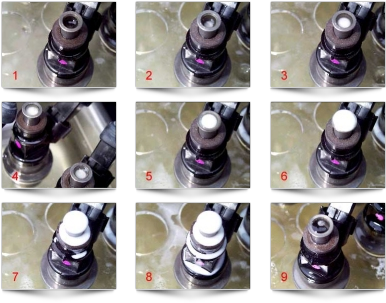
- The filter baskets are removed and the injectors are placed in the ultrasonic bath. When switched on, the injectors will be pulsed simultaneously.
- The simultaneous pulsing and the ultrasonic frequency in the Bio Clean Ultrasonic Cleaning Fluid begins to breakdown the baked on deposits left by unleaded fuels.
- The combination of ultrasonic frequency in the Bio Clean Ultrasonic Cleaning Fluid continues the cleaning process.
- The patented reverse flow program begins to push the fluid back up inside the injectors breakdown the baked on deposits left by the un-leaded fuels.
- During the 30 minute cycle, the fluid continues to flow back up the injector
- The emulsified deposits eventually spill out of the top of the injector.
- The cleaning process must continue until the chemicals have gone and the fluid is clear one again.
- The Injector is now clean
After Ultrasonic Cleaning the fuel droplet size has been reduced and the amount of unburnt fuel has been reduced, giving better ENGINE PERFORMANCE, IMPROVED FUEL ECONOMY, LOWER EXHAUST EMISSIONS
The Benefits of Ultrasonic Fuel Injector Cleaning
- Correct Diagnosis. It is impossible to measure the condition and performance of the injectors while they are on the car.
- Save Time & Money. A great deal of money and many hours, are spent trying to solve engine related problems that could be caused by poor injector performance.
- Emission Control & Reduction. Without testing and servicing the injectors it is impossible to guarantee the minimum pollution.
- Restored & Increased Performance. Poor injector performance will be reflected in the cars overall performance. Servicing injectors could restore the cars lost performance.
- Reduced Warranty Claims. Vehicle dealerships will be able to correctly confirm or reject injectors warranty claims.
- Improved Fuel Economy. Serviced injectors will produce maximum efficiency and minimum wastage of fuel. Saving on fuel over a 12 month period could far out way the cost of a Pro Flow injector service.
- Satisfied Customers. The customer now expects the best from his car and his garage, Pro Flow ensures that the customers engine repair/service bills are kept to a minimum and quality of servicing to a maximum.












